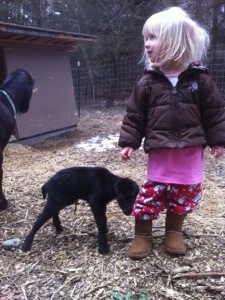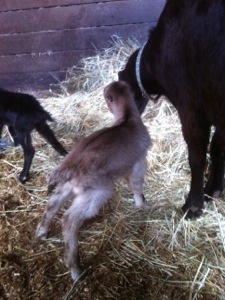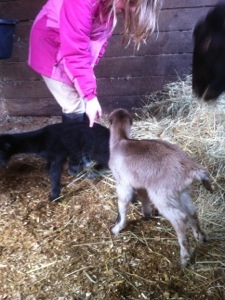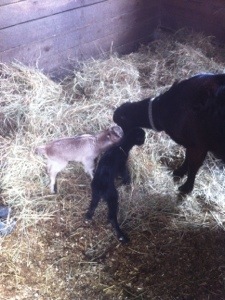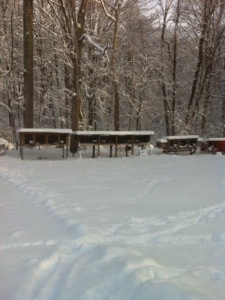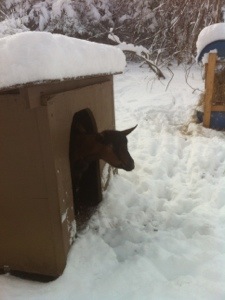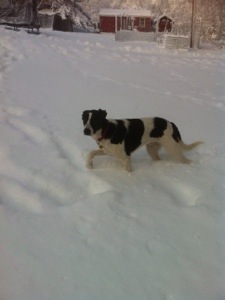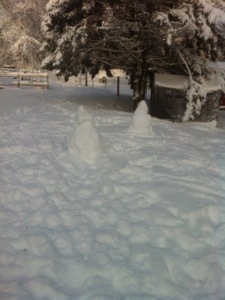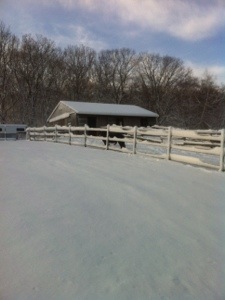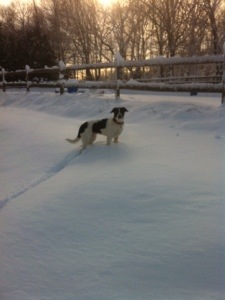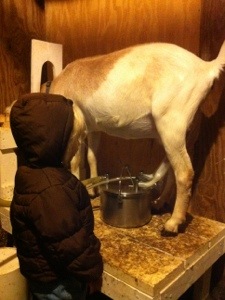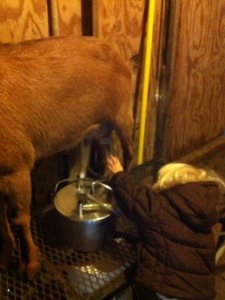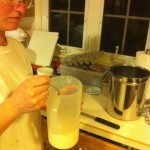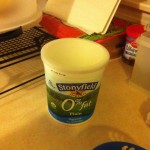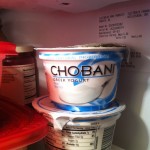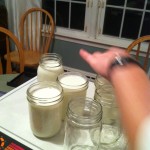Today was the first Saturday in a while that didn’t have kid swimming lessons at 8:30. Since Anna and I were up late (again) talking about the decision of which house to buy, we decided to sleep in. So, when Alex and Vicki showed up in the bedroom at 6:45, we sent them to play and rolled over in bed. By the time we got up and ready for chores, the kids were driving me nuts. I sent them outside to check on Mary and Betty, 2 of the Oberhaslis due to kid today. Since I checked them at 11:30 last night, I didn’t expect any surprises.
I was caught off guard when Alex came running in yelling “Mary has a baby sticking out her butt!” We grabbed our jackets and ran out the door. Anna moved Mary into the kidding stall. She was obviously in distress and the kid’s face and feet were starting to dry off. Anna quickly pulled the buckling and we started to work on getting Mary and the baby help. Mary wasn’t doing well so we got the emergency frozen colostrum warmed for the buckling. After about an hour, both seemed to be stable, so we continued with chores.
As I went to feed the bucks and does in a different pen, I discovered Frosty had 2 kids nursing! I called Anna and I quickly commandeered a horse stall and shuffled Frosty with her doeling and buckling to the horse barn. Frosty was specifically surprising because, after we bred her, the bucks kept showing interest and rebreeding her every 3 weeks. If she was pregnant, we didn’t expect kids until June. However, last night, I told Anna “Frosty is starting to build and udder. I guess she is pregnant.”
Then, I got a phone call and had to head in to work to deal with a problem. I left Anna to deal with the 3 new goat kids and chores for the day.
When I called her later in the day to say I was on my way home, she informed me Betty was now in labor. By the time I stopped at the grocery store and picked up a babysitter, it had been almost an hour. I walked in the horse barn to the second commandeered horse stall to find Anna yelling at me “I need help, the kids are stuck!” I took off my jacket, rolled up my sleeves, and headed in.
30 minutes later, another buckling and doeling were on the ground. Betty got some meds and we made sure all the kids were nursing on their mommas. A quick milking of the other does and round chores for us inside and out of the cold. We both ran through the shower and headed out the door to the Dolphin Scholarship Auction. Now, I am sitting here on my iPhone writing this during the auction. We will head home in a while and check on all the kids. Then to bed.
Hopefully tomorrow will have fewer surprises. The next goat isn’t due until April. We think.
Here are some pictures of Frosty’s kids.
Vicki has named the doeling Black Sapphire and Alex named the buckling Bedrock.
Category Archives: goats
A night in the kidding stall
Goats normally kid at 150 days +/- 5. On Wednesday, Farrah was at day 153. Anna came into the house about 7 and announced that Farrah was in the kidding stall and had some mucas discharge. Some friends who live a couple of miles down the road were interested in seeing what signs of kidding are, so they came over. About 8, we went to check on Farrah and she was in early labor. Vicki and our friend’s daughter got to hang out in the shed watch for a while. Things didn’t really progress, so the girls went to bed around 9. As the evening continued, Farrah’s labor didn’t improve.
By 10:30, it was time to intervene. I gloved up and reached in and found back legs. The kid was in breach position and I was not at all able to rotate the baby. We had no choice but to pull him out back leg first. Once the kid was out, he was not breathing. Despite our best efforts to clear lungs and do goat CPR, the kid never revived. He was a 10.9lb buckling. There were no other kids. Farrah will get some antibiotics to help prevent infection and we have already begun milking her. We will dump the antibiotic laced milk and then start harvesting for the family.
A disappointing start to kidding season. Hopefully Maggie will do better. She is due in 4 days.
Life on the fringe
Anna and I frequently find ourselves “on the fringe” of society. What I mean by that is, we have moved away from much of what most Americans consider mainstream. Why? Primarily because the more we educate ourselves on decisions, the less we trust “corporate America”. While we are very confident in our choices, we are always willing to learn more. However, there must be actual factual background for choices and not just because it is what everyone else does. Here are some examples:
Goat milk. We chose to get dairy goats with the sole reason of using them for milk for our family. While the stats vary according to the source, in general, it is estimated that about 70% of the world’s population consumes goat milk. In the US, we drink goat milk, and we are on the fringe.
Raw milk. Not only is the milk we drink from a goat, it is UNPASTEURIZED! That’s right. We just filter and chill the milk. Do you think that the 70% of the world drinking goat milk have pasteurization machines in the kitchen? I completely understand why pasteurization exists – to cleanse milk of bacteria/contamination that is likely to be present on large-scale productions. However, it is very clear that unpasteurized milk can be safely produced and consumed on small-scale operations (like a family farm).
Raising our own meat. Our kids know the rabbits in the cages will be raised as meat. The chickens will give us eggs, and then they too will be dinner. You know what? They are not traumatized by this, because they don’t have illusions that meat comes from a mysterious factory in another place. Our children understand the life cycle better than some adults I have met. Choosing to raise meat, that isn’t injected with antibiotics, somehow puts us on the fringe. About 100 years ago we would have been considered normal.
Barefoot horses. Facts: horses in the wild do not have shoes, do not get trimmed by humans, do not exhibit many of the pathologies and hoof problems in domestic horses, and live longer. Yet, with all that reality, somehow Americans have become convinced that barefoot horses are the oddballs! I seriously have to defend the choice to leave shoes off or remove shoes from horses! Why don’t owners who have shod horses have to defend their choice since that is the unnatural path? Owning horses without metal plates nailed to hooves puts us on the fringe.
Rejecting chemical fertilizers. We choose to not use chemicals in our gardens, on our grass, in the pastures, or otherwise around the farm whenever possible. I’m not saying there is never a time and place for that, but we don’t feel the default choice should be a chemical. Organic practices put us on the fringe.
TV shows. There are some tv shows that I will not watch based on principle. I have never, and will never, watch American Idol, solely due to the name. I refuse to encourage or support the idolization of individuals in society. And yes, it extends way beyond tv. I heard there was a football game on tv yesterday. I didn’t watch it, because I am disappointed in the pedestal our society places professional athletes upon; the same athletes who are frequently poor role models.
Cooking. We (usually Anna but me too) cook food. I mean with actual ingredients. For example, Anna made cookies, and it didn’t involve a single box with 1 egg and water. Our kids look forward to special occasions because it means they might get to have a soda (there are none in the house). Dinner at a restaurant is exciting to the kids. McDonald’s is a rare treat. Sure, there are some quick and easy dinner options in the cabinet or freezer, but they are the exception around here. And by the way, we threw out all our non-stick and only cook in cast iron or stainless steel.
Church. We go to church regularly. This creates conflicts with horse shows, goa t shows, kid activities etc. People are surprised when you say Sunday morning is a conflict because you go to church. When did going to church become something for those on the fringe?
Don’t get me wrong, I’m not judging those who differ in opinions. I just can’t quite grasp how society seems to have shifted so much, that what was mainstream 100 years ago, has left us on the fringe…
Goat’s milk – by the numbers
Since our last doe has been dried up and we are getting ready for kidding season, I closed out the milk records for last season. If you are not familiar with the dairy industry, milk production is actually tracked and discussed by weight (pounds of milk), not volume. While it was obvious on a day-to-day basis what the production of the goats was, we decided last June to start tracking it for analysis (I am an engineer after all). So, after each milking, we would weigh the milk for the doe and record it on a sheet in the milking area. Then, at the end of the month, I entered the data into a spreadsheet.
This year, we had 4 goats in milk. We chose to only milk 1 time a day because it provided enough milk for us and reduced the chore load in the evenings. When we dropped to 1 time a day, we saw the daily total for each goat drop by about 30%. Lilly was sold shortly after starting the records, so she is excluded from the totals. Here is how the others did.
Saffron – Lamancha, first freshener. 283 days in milk. 840 lbs produced. 3.0lbs avg per day over entire cycle.
Tang – Lamancha, first freshener. 266 days in milk. 656 lbs produced. 2.5lbs avg per day over entire cycle.
Betty – Oberhasli, second freshener. 303 days in milk. 565 lbs produced. 1.9lbs avg per day over entire cycle.
Total for the 3 goats: 2061 lbs, or about 257 gallons. If we were purchasing raw cow milk, it would have a value of $2570. If we were purchasing raw goat milk, it would have a value of $5140. If we were purchasing the milk, we probably wouldn’t use as much as we do.
We had already observed that our Oberhasli’s don’t produce nearly as much as the Lamanchas. Therefore, if we decided to change to a single breed, it would be Lamanchas. Of course, we are not in this from a maximum production standpoint.
Conclusions. We use a lot of milk. It is cheaper to raise your own goats for milk than to buy milk.
2012 review, 2013 plans
First, Thank You to everyone who supported Sawyer Family Farm in 2012!
Last year was marked by significant growth and trying new things on the farm and we learned a lot. When we started our farm, it was with the intent to provide healthier food for our family, that we could trust was free of antibiotics, artificial hormones, injected juices, and all the other things that we don’t know about in the mainstream food supply. We are well on our way to achieving that goal. Frequently last summer, we were able to serve entire meals with items produced exclusively on our farm: meat, vegetables, and dairy products. We enjoy raising the animals, however, it is a lot of work (just ask our farm sitter who experienced the life for 10 days while we were gone at Christmas)! A frequent conversation starter at our house is “What do we enjoy, what do make money at, and what isn’t worth the money.”
So, here is a breakdown across the areas we tried out in 2012 and some of our 2013 plans.
Eggs: There is a constant demand for our eggs. We love the idea of having a cooler at the end of our driveway to sell fresh eggs to local neighbors, however, after losing around $100 in coolers, eggs, and money, we had to stop. We have been providing eggs to other groups such as Wesleyan University Food Co-op and for sale on CT Farm Fresh Express, however, our local customers come first, so if you still want our fresh eggs, give us a call. 2013: We will continue to have fresh eggs available, however, we will not expand our laying flock. NOTE: we are getting ready for chick hatching season soon, so eggs may not be quite as available as we set them aside for hatching.
Meat Chickens: Wow. I never expected so much demand for the meat chickens. We ended up selling almost half of what we planning to keep for ourselves, but that is ok, because we have been eating more rabbits. In 2012, we tried Freedom Rangers as a meat chicken and also raised more heritage roosters. While we didn’t raise any Cornish Cross, we did process them on a number of occasions for another farm. While the Cornish Cross get bigger, have more breast meat, and are ready in half the time, we have decided they WILL NOT be raised on our farm. Additionally, we will not raise the Freedom Rangers again. We have decided that we prefer chickens that move around, scratch the grass, and act like chickens, even if that means it takes longer to raise them at a slightly higher cost.
2013: We will still raise some chickens as meat birds. However, based on the time it takes to process when they are all ready (and our extremely busy weekend schedules), we will likely have a very limited number of chickens available for sale. These will be offered to previous customers first.
Chicks: We hatched a lot of chicks in 2012 on a continuous hatching plan. This year, are going to try a very different approach. Stand by for an update on this within the next week.
Turkeys: Turkeys are stupid. That’s all there is too it. While we did get excellent feedback, we haven’t decided if the turkeys are worth the trouble. It was definitely more stressful than I anticipated as we approached Thanksgiving and realized many of the birds were going to be smaller than expected. We haven’t decided what future turkeys will have on the farm, however, we are committed to the heritage breeds if we raise them again.
Rabbits: This has to be one of the more frustrating areas of the farm. The rabbits are easier to care for than the chickens, easier to breed year round, and require less work. However, due to the feed costs, they are more expensive, which I think is negatively impacting our ability to sell more rabbits. Additionally, since rabbit isn’t a mainstream food source in the US, many are reluctant to try it. Rabbits are not going away (in fact we would really like to expand). We have a few ideas about what we might be able to do in order to lower costs for feeding. Stand by for a new project announcement in the near future.
Goats: We love the goats. They are just fun. The human kids enjoyed showing last summer at the North Stonington Fair, and this year, in 4-H, they will show goats a little more. Last summer, we used the milk to drink (a lot), make ice cream, and make soft cheese until we got tired of goat cheese and wine (which takes about 3 months, every evening after the human kids go to bed). Right now we have 9 does that we think are all bred. Kidding season starts in February and continues into early June. We haven’t completely decided on how large our dairy herd will be in the future, however, we do plan to sell a lot of kids (goat version only). Anna has grand plans to make hard cheeses (as soon as I buy or build a press) and soaps. That’s right, we will be selling Goat’s Milk soap and other skin care products in 2013.
Beef: We didn’t do anything with raising beef in 2012. However, we did by half a veal calf from some friends who also raise goats, and the meat was fabulous. We got 40lbs of meat from our half calf. Our plan is, buy a bob calf (male dairy calf) at less than a week old. Switch it over to goat milk and raise it for 2-3 months. The calf will live with the goats and be raised on milk and hay – no grains. We will pre-sell the calves as a whole or half calf and you pick up your meat at the butcher. More info and pricing will be available in the future, however this will be a very limited commodity.
Horses: Anna has been teaching some lessons. She is very good at it, even if she doesn’t believe that herself. At dinner the other night, Alex even stated his favorite riding instructor was his Mom! This year, we expect to continue to expand our horse involvement as the kids are more active in Pony Club and Anna and I try to riding more hunter paces for ourselves. We became dealers for a number of horse care products, primarily as associated with my trimming work. Horses have always been our first passion, and we are always challenged to make time for that as the other activities on the farm grow.
2013 resolutions:
Stay true to heritage breeds.
Continue to find efficiencies on farm.
Reduce reliance on commercial feed.
Have fun.
Snow covered farm!
Amanda the milk maid
Making Yogurt
Earlier in the year, our family developed an expensive food habit: yogurt. We were using yogurt on cereal at breakfast, for snacks, in smoothies. In fact, we were easily spending over $60 a month just on yogurt (normally Stonyfield and Chobani). Since we have all our own milk, we decided to start making some yogurt on our own from goat’s milk. It’s very easy.
1. Pasteurize the milk. While we drink it raw, we pasteurize it for yogurt to ensure only the desired culture grows.
2. Add 3-4 tablespoons of plain yogurt from the store per quart of milk. (We tried purchased cultures, but didn’t like the flavor and for the cost, it’s cheaper to just get a little from the store.
3. Pour into pint jars. We sterilize the jars first because when we didn’t, other cultures started to grow after about 3 weeks of storage.
4. Load into Excaliber Dehydrator.
5. Cook at 100F for 6-8 hrs.
6. Refrigerate.
The consistency is much more liquid than store-bought yogurt, similar to European yogurt. Anna is fine with that. I found that it was only a mental issue to get past and now enjoy the yogurt just fine. Alex and Vicki stay away, but they were really only eating the yogurt in smoothies anyways. Amanda will eat whatever Anna and I eat, so she’s happy.
Now selling Equine (and Caprine) Products!
Everyone knows I get very passionate about farming in general, but horses in particular. As my trimming business has been increasing, I find myself constantly talking about the products we like best on our own farm. So, after some discussion, Anna and I have decided to start selling some equine products. The good news is, some of these double as great Caprine (goat) products too! We are now dealers for Easy Care Inc horse hoof boots, Zephyr’s Garden topical horse and dog products, and NibbleNet hay slow feeders. All of these products are items we use on our own farm and can attest to the quality and value. We absolutely love the Zephyr’s Garden products because they are non-toxic, so they are safe for the horses, kids, and goats! Check out our Equine Products page for details!
A lot of Firsts!
Alex had his first horse show at the North Stonington Fair! He rode Precious in 3 walk-trot classes and got 2-4ths and a 3rd. His favorite part? Getting the ribbons.
Vicki had her first horse show at the North Stonington Fair! She rode King in a lead line class, with me as the lead holder. She got third and can’t wait to show more. She is actually ready to show in walk-trot, but Devil needs a little more reovery time first.
Anna had her first student enter a show! Kenzie rode Precious in the lead line class with Vicki. It was also her first show ever and she had a ton of fun!
Since King was already there, I rode him in 5 classes. I managed to get 1st in 2 of the classes and won Grand Champion in the English division.
6 of our rabbits got 1st place in the rabbit show at the North Stonington Fair, and one also got Runner Up for Open Show Champion!
After about a year of owning goats, we finally sold our first goat. That was followed about 30 minutes later with our second and third sales of goats to a different family.
Tomorrow we will have our first goat show! The main focus for tomorrow is to learn about showing and make sure Vicki and Alex have fun doing it.

